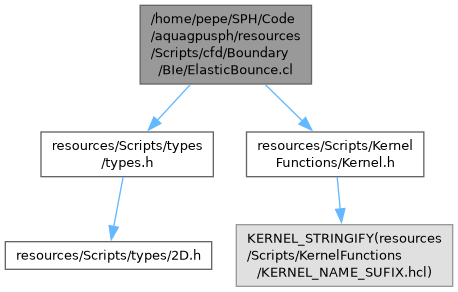The simplest boundary technique to assert the non-tresspasable boundary condition. More...
Include dependency graph for ElasticBounce.cl:

Macros | |
| #define | __DR_FACTOR__ 0.5f |
| The boundary elements effect is restricted to a quadrangular area of \( R \times R \), where \( R = DR_FACTOR \cdot \Delta r \). | |
| #define | __MIN_BOUND_DIST__ 0.0f |
| The elastic bounce is not tolerating that a particle becomes closer than this distance (multiplied by \( \Delta r \)). | |
| #define | _U_ u_i |
| #define | _DUDT_ dudt[i].XYZ |
Functions | |
| __kernel void | entry (const __global int *imove, const __global vec *r_in, const __global vec *normal, const __global float *m, const __global vec *u_in, __global vec *dudt, usize N, float dt, LINKLIST_LOCAL_PARAMS) |
| Performs the boundary effect on the fluid particles. | |
| __kernel void | force_bound (const __global int *imove, const __global float *m, const __global vec *dudt_preelastic, const __global vec *dudt_elastic, __global vec *force_elastic, usize N) |
| Compute the force of each fluid particle on the boundary due to the elastic bounce. | |
Detailed Description
The simplest boundary technique to assert the non-tresspasable boundary condition.
Macro Definition Documentation
◆ __DR_FACTOR__
| #define __DR_FACTOR__ 0.5f |
The boundary elements effect is restricted to a quadrangular area of \( R \times R \), where \( R = DR_FACTOR \cdot \Delta r \).
◆ __MIN_BOUND_DIST__
| #define __MIN_BOUND_DIST__ 0.0f |
The elastic bounce is not tolerating that a particle becomes closer than this distance (multiplied by \( \Delta r \)).
◆ _DUDT_
| #define _DUDT_ dudt[i].XYZ |
◆ _U_
| #define _U_ u_i |
Function Documentation
◆ entry()
| __kernel void entry | ( | const __global int * | imove, |
| const __global vec * | r_in, | ||
| const __global vec * | normal, | ||
| const __global float * | m, | ||
| const __global vec * | u_in, | ||
| __global vec * | dudt, | ||
| usize | N, | ||
| float | dt, | ||
| LINKLIST_LOCAL_PARAMS | ) |
Performs the boundary effect on the fluid particles.
- Parameters
-
imove Moving flags. - imove > 0 for regular fluid particles.
- imove = 0 for sensors.
- imove < 0 for boundary elements/particles.
r Position \( \mathbf{r} \). normal Normal \( \mathbf{n} \). m Area \( s \). u_in Velocity \( \mathbf{u} \). dudt Velocity rate of change \( \left. \frac{d \mathbf{u}}{d t} \right\vert_{n+1} \). N Number of particles. dt Time step \( \Delta t \). icell Cell where each particle is located. ihoc Head of chain for each cell (first particle found). n_cells Number of cells in each direction
◆ force_bound()
| __kernel void force_bound | ( | const __global int * | imove, |
| const __global float * | m, | ||
| const __global vec * | dudt_preelastic, | ||
| const __global vec * | dudt_elastic, | ||
| __global vec * | force_elastic, | ||
| usize | N ) |
Compute the force of each fluid particle on the boundary due to the elastic bounce.
- Parameters
-
imove Moving flags. - imove > 0 for regular fluid particles.
- imove = 0 for sensors.
- imove < 0 for boundary elements/particles.
m Mass \( m \). dudt_preelastic Velocity rate of change before the elastic bounce \( \left. \frac{d \mathbf{u}}{d t} \right\vert_{n+1} \). dudt_elastic Velocity rate of change after the elatic bounce \( \left. \frac{d \mathbf{u}}{d t} \right\vert_{n+1} \). N Number of particles.
Generated by